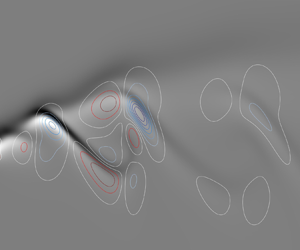Published online by Cambridge University Press: 07 February 2022

This study investigates the stability features of spatially spreading heated jets in the viscous regime with real gas effects, using both unsteady two-dimensional axisymmetric simulations and linear analyses of the steady state and time-averaged states. At a Reynolds number of  $400$, the heated jets are found to undergo a subcritical Hopf bifurcation, marking the start of self-sustained oscillations when decreasing the temperature ratio
$400$, the heated jets are found to undergo a subcritical Hopf bifurcation, marking the start of self-sustained oscillations when decreasing the temperature ratio  $S=T_{\infty }/T_{{c}}$, which highly depends on the thermodynamic and transport property assumptions imposed in the simulations. Once the flow enters a limit cycle past the Hopf bifurcation, the linear analyses over the steady base state are unable to capture the oscillation's frequency. Nevertheless, this study confirms that including real gas effects in the stability equations has a strong effect on the growth rate of the global mode once the centreline temperature of the jet reaches that of the dissociation reaction onset, which is
$S=T_{\infty }/T_{{c}}$, which highly depends on the thermodynamic and transport property assumptions imposed in the simulations. Once the flow enters a limit cycle past the Hopf bifurcation, the linear analyses over the steady base state are unable to capture the oscillation's frequency. Nevertheless, this study confirms that including real gas effects in the stability equations has a strong effect on the growth rate of the global mode once the centreline temperature of the jet reaches that of the dissociation reaction onset, which is  $T=2800$ K for air at
$T=2800$ K for air at  $p_s=100$ mbar. The linear global analyses over the time-averaged states lead to a satisfying prediction of the oscillation's frequency for the cases studied, and the baroclinic torque obtained from the resulting global mode matches well with that of the simulations.
$p_s=100$ mbar. The linear global analyses over the time-averaged states lead to a satisfying prediction of the oscillation's frequency for the cases studied, and the baroclinic torque obtained from the resulting global mode matches well with that of the simulations.